NEXT: Understanding and Leading Change Management Report
VerifiedAdded on 2020/10/22
|12
|4050
|56
Report
AI Summary
This report examines change management strategies within NEXT, a prominent multinational clothing retailer. It begins with a comparison of NEXT to H&M, highlighting the impact of change on their respective strategies and operations, including pricing, product offerings, promotional activities, and market presence. The report then delves into the internal and external drivers of change affecting leadership, team dynamics, and individual behaviors within NEXT, categorizing these drivers as strengths, weaknesses, opportunities, threats, political factors, economic factors, social factors, and technological factors. Furthermore, the report outlines measures for minimizing the negative impacts of change on organizational behavior, emphasizing research and strategic planning. The report also addresses the barriers to change and their influence on leadership decision-making, and concludes by exploring different leadership approaches for dealing with change within the organization, providing a comprehensive analysis of how NEXT navigates and manages change within its business operations.
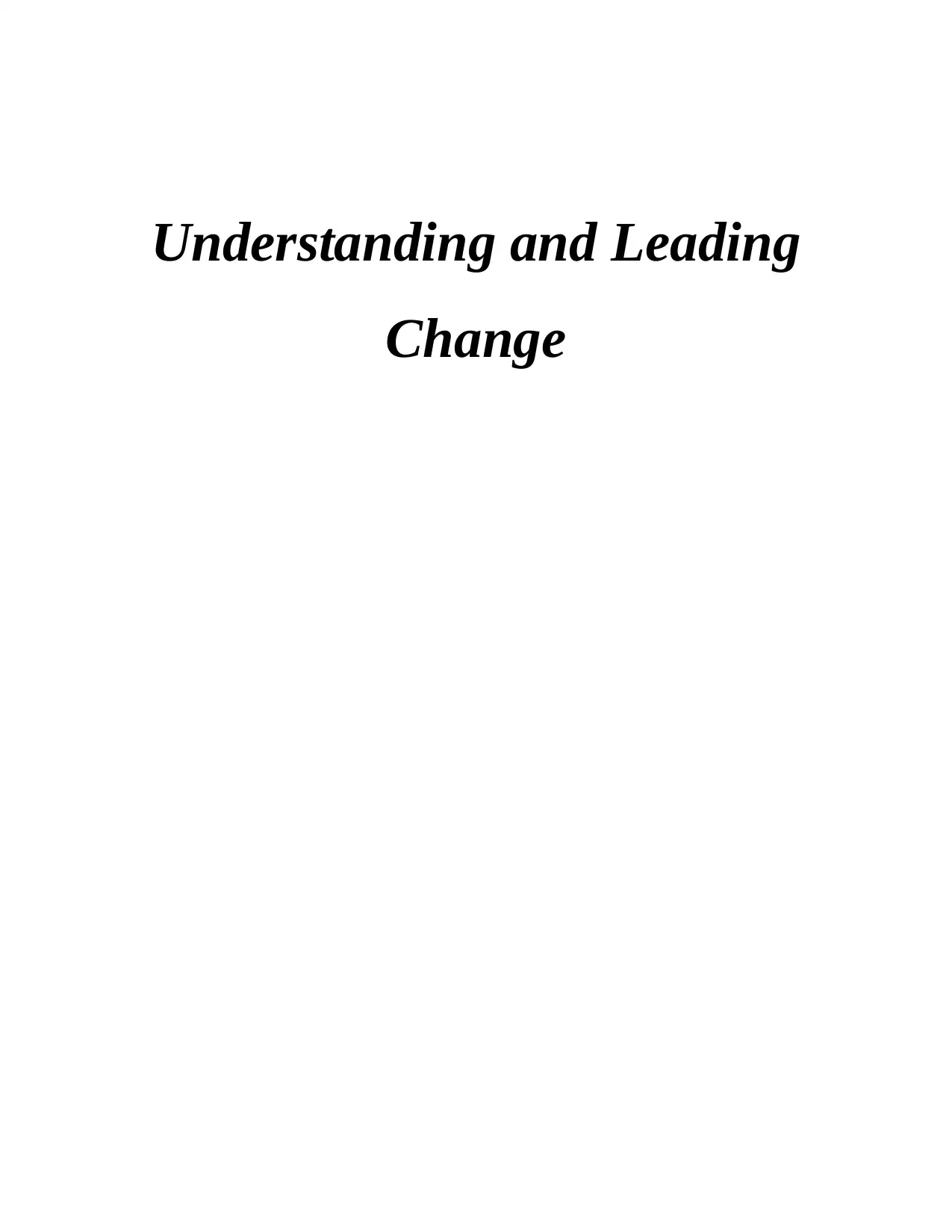
Understanding and Leading
Change
Change
Paraphrase This Document
Need a fresh take? Get an instant paraphrase of this document with our AI Paraphraser
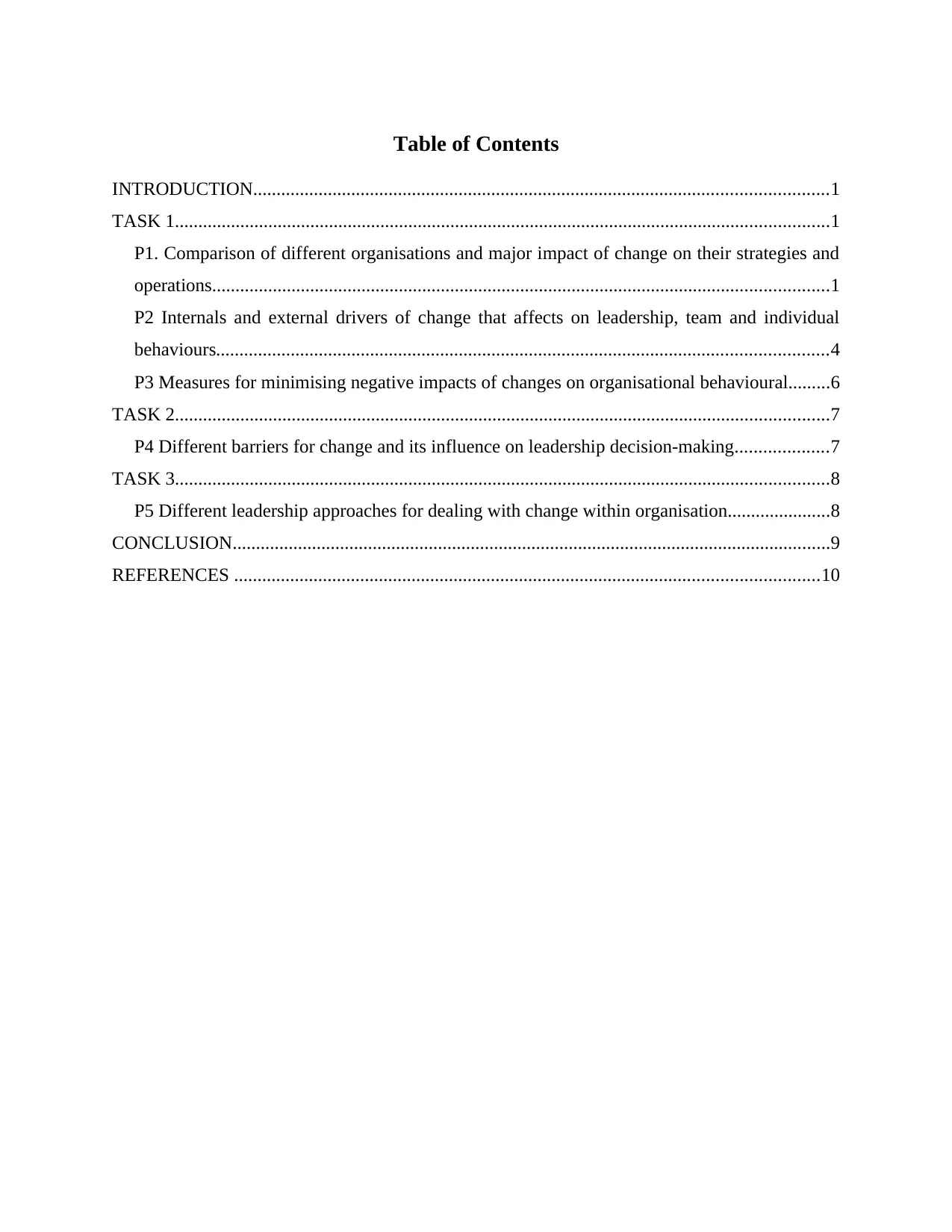
Table of Contents
INTRODUCTION...........................................................................................................................1
TASK 1............................................................................................................................................1
P1. Comparison of different organisations and major impact of change on their strategies and
operations....................................................................................................................................1
P2 Internals and external drivers of change that affects on leadership, team and individual
behaviours...................................................................................................................................4
P3 Measures for minimising negative impacts of changes on organisational behavioural.........6
TASK 2............................................................................................................................................7
P4 Different barriers for change and its influence on leadership decision-making....................7
TASK 3............................................................................................................................................8
P5 Different leadership approaches for dealing with change within organisation......................8
CONCLUSION................................................................................................................................9
REFERENCES .............................................................................................................................10
INTRODUCTION...........................................................................................................................1
TASK 1............................................................................................................................................1
P1. Comparison of different organisations and major impact of change on their strategies and
operations....................................................................................................................................1
P2 Internals and external drivers of change that affects on leadership, team and individual
behaviours...................................................................................................................................4
P3 Measures for minimising negative impacts of changes on organisational behavioural.........6
TASK 2............................................................................................................................................7
P4 Different barriers for change and its influence on leadership decision-making....................7
TASK 3............................................................................................................................................8
P5 Different leadership approaches for dealing with change within organisation......................8
CONCLUSION................................................................................................................................9
REFERENCES .............................................................................................................................10
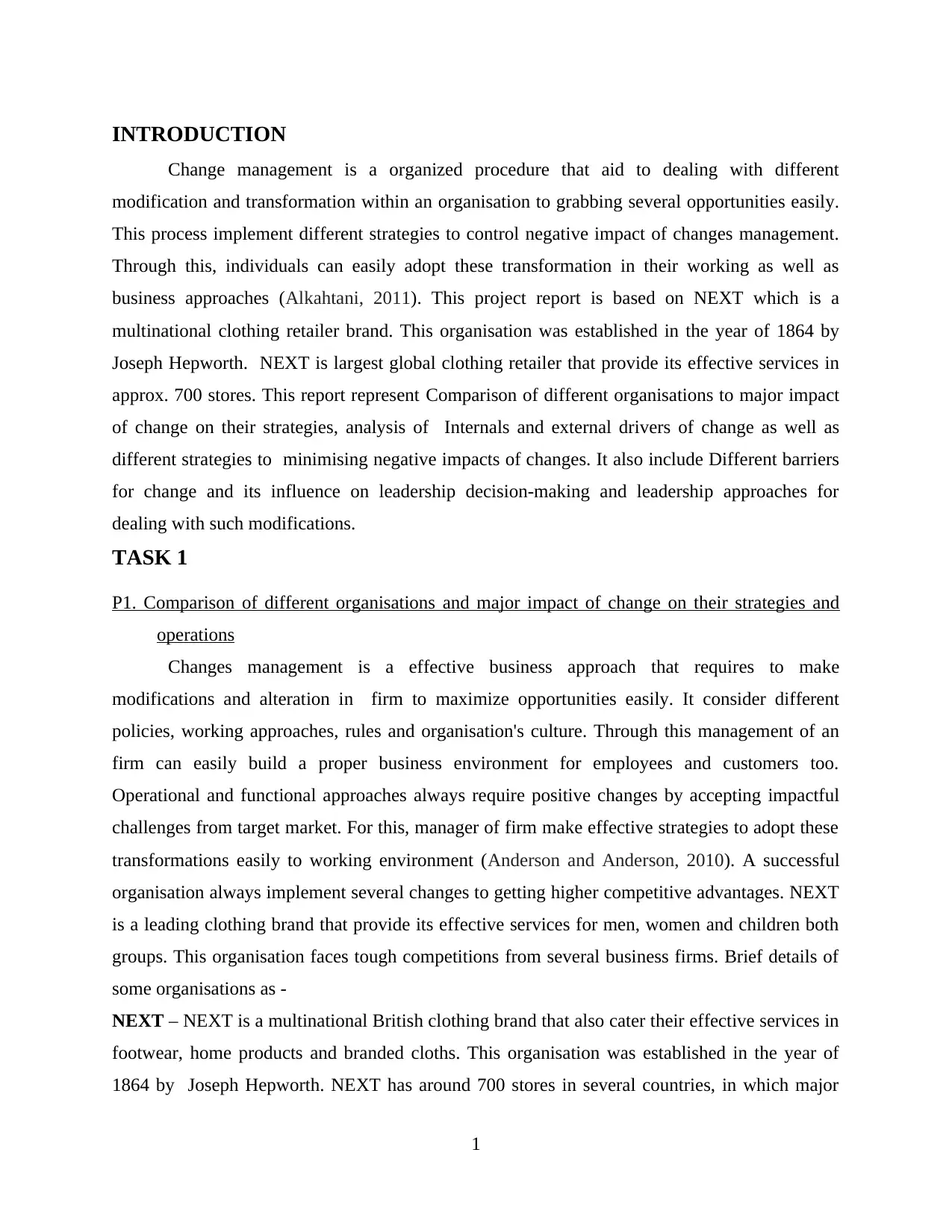
INTRODUCTION
Change management is a organized procedure that aid to dealing with different
modification and transformation within an organisation to grabbing several opportunities easily.
This process implement different strategies to control negative impact of changes management.
Through this, individuals can easily adopt these transformation in their working as well as
business approaches (Alkahtani, 2011). This project report is based on NEXT which is a
multinational clothing retailer brand. This organisation was established in the year of 1864 by
Joseph Hepworth. NEXT is largest global clothing retailer that provide its effective services in
approx. 700 stores. This report represent Comparison of different organisations to major impact
of change on their strategies, analysis of Internals and external drivers of change as well as
different strategies to minimising negative impacts of changes. It also include Different barriers
for change and its influence on leadership decision-making and leadership approaches for
dealing with such modifications.
TASK 1
P1. Comparison of different organisations and major impact of change on their strategies and
operations
Changes management is a effective business approach that requires to make
modifications and alteration in firm to maximize opportunities easily. It consider different
policies, working approaches, rules and organisation's culture. Through this management of an
firm can easily build a proper business environment for employees and customers too.
Operational and functional approaches always require positive changes by accepting impactful
challenges from target market. For this, manager of firm make effective strategies to adopt these
transformations easily to working environment (Anderson and Anderson, 2010). A successful
organisation always implement several changes to getting higher competitive advantages. NEXT
is a leading clothing brand that provide its effective services for men, women and children both
groups. This organisation faces tough competitions from several business firms. Brief details of
some organisations as -
NEXT – NEXT is a multinational British clothing brand that also cater their effective services in
footwear, home products and branded cloths. This organisation was established in the year of
1864 by Joseph Hepworth. NEXT has around 700 stores in several countries, in which major
1
Change management is a organized procedure that aid to dealing with different
modification and transformation within an organisation to grabbing several opportunities easily.
This process implement different strategies to control negative impact of changes management.
Through this, individuals can easily adopt these transformation in their working as well as
business approaches (Alkahtani, 2011). This project report is based on NEXT which is a
multinational clothing retailer brand. This organisation was established in the year of 1864 by
Joseph Hepworth. NEXT is largest global clothing retailer that provide its effective services in
approx. 700 stores. This report represent Comparison of different organisations to major impact
of change on their strategies, analysis of Internals and external drivers of change as well as
different strategies to minimising negative impacts of changes. It also include Different barriers
for change and its influence on leadership decision-making and leadership approaches for
dealing with such modifications.
TASK 1
P1. Comparison of different organisations and major impact of change on their strategies and
operations
Changes management is a effective business approach that requires to make
modifications and alteration in firm to maximize opportunities easily. It consider different
policies, working approaches, rules and organisation's culture. Through this management of an
firm can easily build a proper business environment for employees and customers too.
Operational and functional approaches always require positive changes by accepting impactful
challenges from target market. For this, manager of firm make effective strategies to adopt these
transformations easily to working environment (Anderson and Anderson, 2010). A successful
organisation always implement several changes to getting higher competitive advantages. NEXT
is a leading clothing brand that provide its effective services for men, women and children both
groups. This organisation faces tough competitions from several business firms. Brief details of
some organisations as -
NEXT – NEXT is a multinational British clothing brand that also cater their effective services in
footwear, home products and branded cloths. This organisation was established in the year of
1864 by Joseph Hepworth. NEXT has around 700 stores in several countries, in which major
1
⊘ This is a preview!⊘
Do you want full access?
Subscribe today to unlock all pages.

Trusted by 1+ million students worldwide
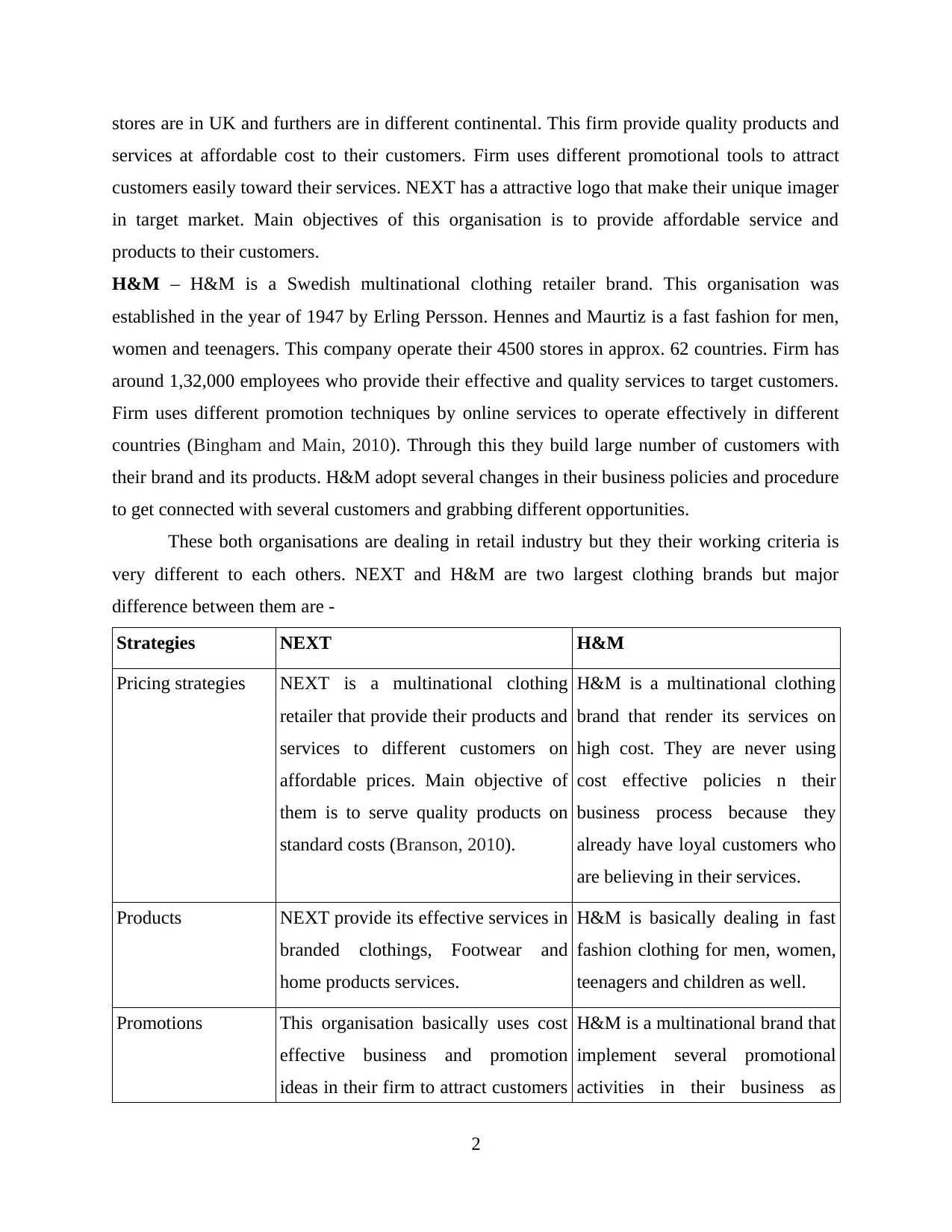
stores are in UK and furthers are in different continental. This firm provide quality products and
services at affordable cost to their customers. Firm uses different promotional tools to attract
customers easily toward their services. NEXT has a attractive logo that make their unique imager
in target market. Main objectives of this organisation is to provide affordable service and
products to their customers.
H&M – H&M is a Swedish multinational clothing retailer brand. This organisation was
established in the year of 1947 by Erling Persson. Hennes and Maurtiz is a fast fashion for men,
women and teenagers. This company operate their 4500 stores in approx. 62 countries. Firm has
around 1,32,000 employees who provide their effective and quality services to target customers.
Firm uses different promotion techniques by online services to operate effectively in different
countries (Bingham and Main, 2010). Through this they build large number of customers with
their brand and its products. H&M adopt several changes in their business policies and procedure
to get connected with several customers and grabbing different opportunities.
These both organisations are dealing in retail industry but they their working criteria is
very different to each others. NEXT and H&M are two largest clothing brands but major
difference between them are -
Strategies NEXT H&M
Pricing strategies NEXT is a multinational clothing
retailer that provide their products and
services to different customers on
affordable prices. Main objective of
them is to serve quality products on
standard costs (Branson, 2010).
H&M is a multinational clothing
brand that render its services on
high cost. They are never using
cost effective policies n their
business process because they
already have loyal customers who
are believing in their services.
Products NEXT provide its effective services in
branded clothings, Footwear and
home products services.
H&M is basically dealing in fast
fashion clothing for men, women,
teenagers and children as well.
Promotions This organisation basically uses cost
effective business and promotion
ideas in their firm to attract customers
H&M is a multinational brand that
implement several promotional
activities in their business as
2
services at affordable cost to their customers. Firm uses different promotional tools to attract
customers easily toward their services. NEXT has a attractive logo that make their unique imager
in target market. Main objectives of this organisation is to provide affordable service and
products to their customers.
H&M – H&M is a Swedish multinational clothing retailer brand. This organisation was
established in the year of 1947 by Erling Persson. Hennes and Maurtiz is a fast fashion for men,
women and teenagers. This company operate their 4500 stores in approx. 62 countries. Firm has
around 1,32,000 employees who provide their effective and quality services to target customers.
Firm uses different promotion techniques by online services to operate effectively in different
countries (Bingham and Main, 2010). Through this they build large number of customers with
their brand and its products. H&M adopt several changes in their business policies and procedure
to get connected with several customers and grabbing different opportunities.
These both organisations are dealing in retail industry but they their working criteria is
very different to each others. NEXT and H&M are two largest clothing brands but major
difference between them are -
Strategies NEXT H&M
Pricing strategies NEXT is a multinational clothing
retailer that provide their products and
services to different customers on
affordable prices. Main objective of
them is to serve quality products on
standard costs (Branson, 2010).
H&M is a multinational clothing
brand that render its services on
high cost. They are never using
cost effective policies n their
business process because they
already have loyal customers who
are believing in their services.
Products NEXT provide its effective services in
branded clothings, Footwear and
home products services.
H&M is basically dealing in fast
fashion clothing for men, women,
teenagers and children as well.
Promotions This organisation basically uses cost
effective business and promotion
ideas in their firm to attract customers
H&M is a multinational brand that
implement several promotional
activities in their business as
2
Paraphrase This Document
Need a fresh take? Get an instant paraphrase of this document with our AI Paraphraser
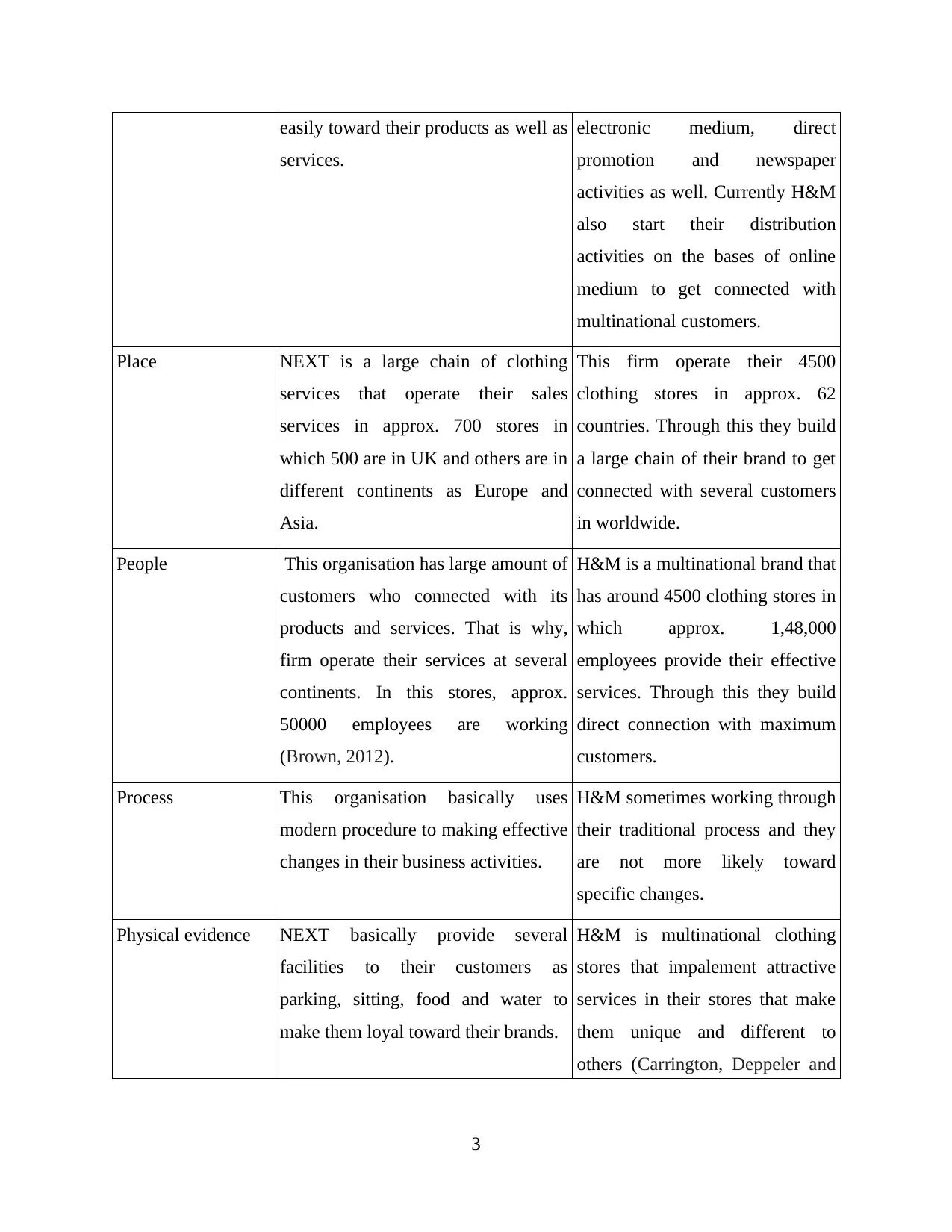
easily toward their products as well as
services.
electronic medium, direct
promotion and newspaper
activities as well. Currently H&M
also start their distribution
activities on the bases of online
medium to get connected with
multinational customers.
Place NEXT is a large chain of clothing
services that operate their sales
services in approx. 700 stores in
which 500 are in UK and others are in
different continents as Europe and
Asia.
This firm operate their 4500
clothing stores in approx. 62
countries. Through this they build
a large chain of their brand to get
connected with several customers
in worldwide.
People This organisation has large amount of
customers who connected with its
products and services. That is why,
firm operate their services at several
continents. In this stores, approx.
50000 employees are working
(Brown, 2012).
H&M is a multinational brand that
has around 4500 clothing stores in
which approx. 1,48,000
employees provide their effective
services. Through this they build
direct connection with maximum
customers.
Process This organisation basically uses
modern procedure to making effective
changes in their business activities.
H&M sometimes working through
their traditional process and they
are not more likely toward
specific changes.
Physical evidence NEXT basically provide several
facilities to their customers as
parking, sitting, food and water to
make them loyal toward their brands.
H&M is multinational clothing
stores that impalement attractive
services in their stores that make
them unique and different to
others (Carrington, Deppeler and
3
services.
electronic medium, direct
promotion and newspaper
activities as well. Currently H&M
also start their distribution
activities on the bases of online
medium to get connected with
multinational customers.
Place NEXT is a large chain of clothing
services that operate their sales
services in approx. 700 stores in
which 500 are in UK and others are in
different continents as Europe and
Asia.
This firm operate their 4500
clothing stores in approx. 62
countries. Through this they build
a large chain of their brand to get
connected with several customers
in worldwide.
People This organisation has large amount of
customers who connected with its
products and services. That is why,
firm operate their services at several
continents. In this stores, approx.
50000 employees are working
(Brown, 2012).
H&M is a multinational brand that
has around 4500 clothing stores in
which approx. 1,48,000
employees provide their effective
services. Through this they build
direct connection with maximum
customers.
Process This organisation basically uses
modern procedure to making effective
changes in their business activities.
H&M sometimes working through
their traditional process and they
are not more likely toward
specific changes.
Physical evidence NEXT basically provide several
facilities to their customers as
parking, sitting, food and water to
make them loyal toward their brands.
H&M is multinational clothing
stores that impalement attractive
services in their stores that make
them unique and different to
others (Carrington, Deppeler and
3
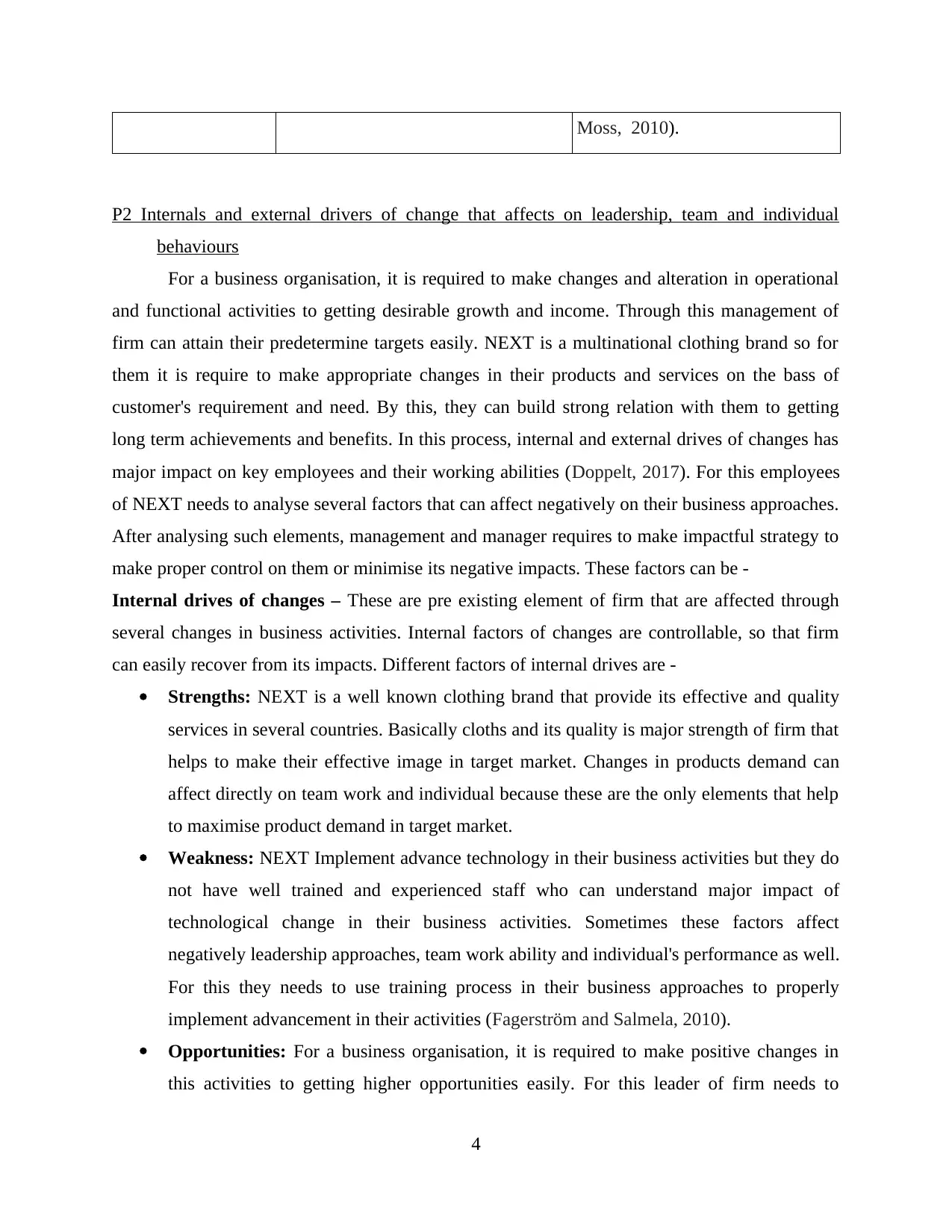
Moss, 2010).
P2 Internals and external drivers of change that affects on leadership, team and individual
behaviours
For a business organisation, it is required to make changes and alteration in operational
and functional activities to getting desirable growth and income. Through this management of
firm can attain their predetermine targets easily. NEXT is a multinational clothing brand so for
them it is require to make appropriate changes in their products and services on the bass of
customer's requirement and need. By this, they can build strong relation with them to getting
long term achievements and benefits. In this process, internal and external drives of changes has
major impact on key employees and their working abilities (Doppelt, 2017). For this employees
of NEXT needs to analyse several factors that can affect negatively on their business approaches.
After analysing such elements, management and manager requires to make impactful strategy to
make proper control on them or minimise its negative impacts. These factors can be -
Internal drives of changes – These are pre existing element of firm that are affected through
several changes in business activities. Internal factors of changes are controllable, so that firm
can easily recover from its impacts. Different factors of internal drives are -
Strengths: NEXT is a well known clothing brand that provide its effective and quality
services in several countries. Basically cloths and its quality is major strength of firm that
helps to make their effective image in target market. Changes in products demand can
affect directly on team work and individual because these are the only elements that help
to maximise product demand in target market.
Weakness: NEXT Implement advance technology in their business activities but they do
not have well trained and experienced staff who can understand major impact of
technological change in their business activities. Sometimes these factors affect
negatively leadership approaches, team work ability and individual's performance as well.
For this they needs to use training process in their business approaches to properly
implement advancement in their activities (Fagerström and Salmela, 2010).
Opportunities: For a business organisation, it is required to make positive changes in
this activities to getting higher opportunities easily. For this leader of firm needs to
4
P2 Internals and external drivers of change that affects on leadership, team and individual
behaviours
For a business organisation, it is required to make changes and alteration in operational
and functional activities to getting desirable growth and income. Through this management of
firm can attain their predetermine targets easily. NEXT is a multinational clothing brand so for
them it is require to make appropriate changes in their products and services on the bass of
customer's requirement and need. By this, they can build strong relation with them to getting
long term achievements and benefits. In this process, internal and external drives of changes has
major impact on key employees and their working abilities (Doppelt, 2017). For this employees
of NEXT needs to analyse several factors that can affect negatively on their business approaches.
After analysing such elements, management and manager requires to make impactful strategy to
make proper control on them or minimise its negative impacts. These factors can be -
Internal drives of changes – These are pre existing element of firm that are affected through
several changes in business activities. Internal factors of changes are controllable, so that firm
can easily recover from its impacts. Different factors of internal drives are -
Strengths: NEXT is a well known clothing brand that provide its effective and quality
services in several countries. Basically cloths and its quality is major strength of firm that
helps to make their effective image in target market. Changes in products demand can
affect directly on team work and individual because these are the only elements that help
to maximise product demand in target market.
Weakness: NEXT Implement advance technology in their business activities but they do
not have well trained and experienced staff who can understand major impact of
technological change in their business activities. Sometimes these factors affect
negatively leadership approaches, team work ability and individual's performance as well.
For this they needs to use training process in their business approaches to properly
implement advancement in their activities (Fagerström and Salmela, 2010).
Opportunities: For a business organisation, it is required to make positive changes in
this activities to getting higher opportunities easily. For this leader of firm needs to
4
⊘ This is a preview!⊘
Do you want full access?
Subscribe today to unlock all pages.

Trusted by 1+ million students worldwide
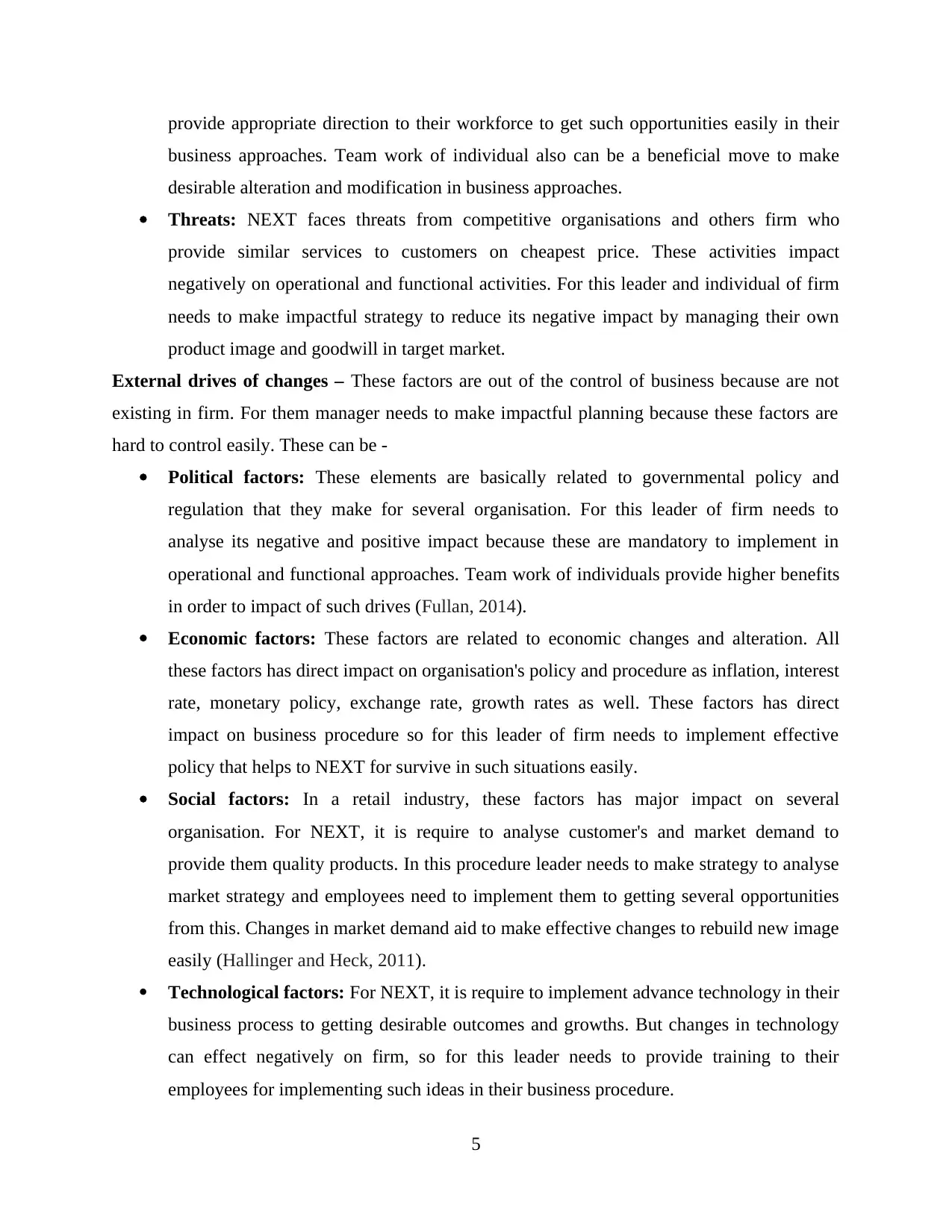
provide appropriate direction to their workforce to get such opportunities easily in their
business approaches. Team work of individual also can be a beneficial move to make
desirable alteration and modification in business approaches.
Threats: NEXT faces threats from competitive organisations and others firm who
provide similar services to customers on cheapest price. These activities impact
negatively on operational and functional activities. For this leader and individual of firm
needs to make impactful strategy to reduce its negative impact by managing their own
product image and goodwill in target market.
External drives of changes – These factors are out of the control of business because are not
existing in firm. For them manager needs to make impactful planning because these factors are
hard to control easily. These can be -
Political factors: These elements are basically related to governmental policy and
regulation that they make for several organisation. For this leader of firm needs to
analyse its negative and positive impact because these are mandatory to implement in
operational and functional approaches. Team work of individuals provide higher benefits
in order to impact of such drives (Fullan, 2014).
Economic factors: These factors are related to economic changes and alteration. All
these factors has direct impact on organisation's policy and procedure as inflation, interest
rate, monetary policy, exchange rate, growth rates as well. These factors has direct
impact on business procedure so for this leader of firm needs to implement effective
policy that helps to NEXT for survive in such situations easily.
Social factors: In a retail industry, these factors has major impact on several
organisation. For NEXT, it is require to analyse customer's and market demand to
provide them quality products. In this procedure leader needs to make strategy to analyse
market strategy and employees need to implement them to getting several opportunities
from this. Changes in market demand aid to make effective changes to rebuild new image
easily (Hallinger and Heck, 2011).
Technological factors: For NEXT, it is require to implement advance technology in their
business process to getting desirable outcomes and growths. But changes in technology
can effect negatively on firm, so for this leader needs to provide training to their
employees for implementing such ideas in their business procedure.
5
business approaches. Team work of individual also can be a beneficial move to make
desirable alteration and modification in business approaches.
Threats: NEXT faces threats from competitive organisations and others firm who
provide similar services to customers on cheapest price. These activities impact
negatively on operational and functional activities. For this leader and individual of firm
needs to make impactful strategy to reduce its negative impact by managing their own
product image and goodwill in target market.
External drives of changes – These factors are out of the control of business because are not
existing in firm. For them manager needs to make impactful planning because these factors are
hard to control easily. These can be -
Political factors: These elements are basically related to governmental policy and
regulation that they make for several organisation. For this leader of firm needs to
analyse its negative and positive impact because these are mandatory to implement in
operational and functional approaches. Team work of individuals provide higher benefits
in order to impact of such drives (Fullan, 2014).
Economic factors: These factors are related to economic changes and alteration. All
these factors has direct impact on organisation's policy and procedure as inflation, interest
rate, monetary policy, exchange rate, growth rates as well. These factors has direct
impact on business procedure so for this leader of firm needs to implement effective
policy that helps to NEXT for survive in such situations easily.
Social factors: In a retail industry, these factors has major impact on several
organisation. For NEXT, it is require to analyse customer's and market demand to
provide them quality products. In this procedure leader needs to make strategy to analyse
market strategy and employees need to implement them to getting several opportunities
from this. Changes in market demand aid to make effective changes to rebuild new image
easily (Hallinger and Heck, 2011).
Technological factors: For NEXT, it is require to implement advance technology in their
business process to getting desirable outcomes and growths. But changes in technology
can effect negatively on firm, so for this leader needs to provide training to their
employees for implementing such ideas in their business procedure.
5
Paraphrase This Document
Need a fresh take? Get an instant paraphrase of this document with our AI Paraphraser
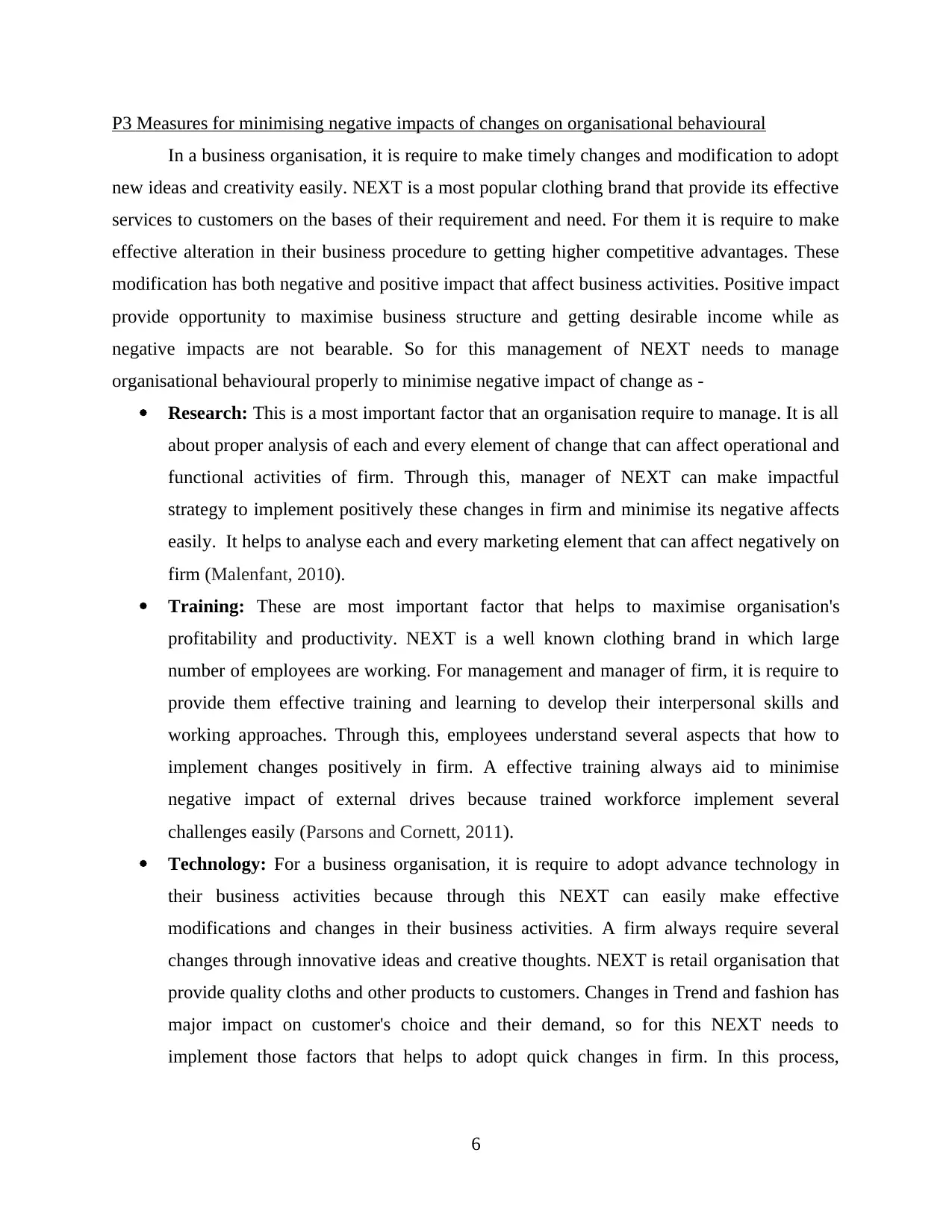
P3 Measures for minimising negative impacts of changes on organisational behavioural
In a business organisation, it is require to make timely changes and modification to adopt
new ideas and creativity easily. NEXT is a most popular clothing brand that provide its effective
services to customers on the bases of their requirement and need. For them it is require to make
effective alteration in their business procedure to getting higher competitive advantages. These
modification has both negative and positive impact that affect business activities. Positive impact
provide opportunity to maximise business structure and getting desirable income while as
negative impacts are not bearable. So for this management of NEXT needs to manage
organisational behavioural properly to minimise negative impact of change as -
Research: This is a most important factor that an organisation require to manage. It is all
about proper analysis of each and every element of change that can affect operational and
functional activities of firm. Through this, manager of NEXT can make impactful
strategy to implement positively these changes in firm and minimise its negative affects
easily. It helps to analyse each and every marketing element that can affect negatively on
firm (Malenfant, 2010).
Training: These are most important factor that helps to maximise organisation's
profitability and productivity. NEXT is a well known clothing brand in which large
number of employees are working. For management and manager of firm, it is require to
provide them effective training and learning to develop their interpersonal skills and
working approaches. Through this, employees understand several aspects that how to
implement changes positively in firm. A effective training always aid to minimise
negative impact of external drives because trained workforce implement several
challenges easily (Parsons and Cornett, 2011).
Technology: For a business organisation, it is require to adopt advance technology in
their business activities because through this NEXT can easily make effective
modifications and changes in their business activities. A firm always require several
changes through innovative ideas and creative thoughts. NEXT is retail organisation that
provide quality cloths and other products to customers. Changes in Trend and fashion has
major impact on customer's choice and their demand, so for this NEXT needs to
implement those factors that helps to adopt quick changes in firm. In this process,
6
In a business organisation, it is require to make timely changes and modification to adopt
new ideas and creativity easily. NEXT is a most popular clothing brand that provide its effective
services to customers on the bases of their requirement and need. For them it is require to make
effective alteration in their business procedure to getting higher competitive advantages. These
modification has both negative and positive impact that affect business activities. Positive impact
provide opportunity to maximise business structure and getting desirable income while as
negative impacts are not bearable. So for this management of NEXT needs to manage
organisational behavioural properly to minimise negative impact of change as -
Research: This is a most important factor that an organisation require to manage. It is all
about proper analysis of each and every element of change that can affect operational and
functional activities of firm. Through this, manager of NEXT can make impactful
strategy to implement positively these changes in firm and minimise its negative affects
easily. It helps to analyse each and every marketing element that can affect negatively on
firm (Malenfant, 2010).
Training: These are most important factor that helps to maximise organisation's
profitability and productivity. NEXT is a well known clothing brand in which large
number of employees are working. For management and manager of firm, it is require to
provide them effective training and learning to develop their interpersonal skills and
working approaches. Through this, employees understand several aspects that how to
implement changes positively in firm. A effective training always aid to minimise
negative impact of external drives because trained workforce implement several
challenges easily (Parsons and Cornett, 2011).
Technology: For a business organisation, it is require to adopt advance technology in
their business activities because through this NEXT can easily make effective
modifications and changes in their business activities. A firm always require several
changes through innovative ideas and creative thoughts. NEXT is retail organisation that
provide quality cloths and other products to customers. Changes in Trend and fashion has
major impact on customer's choice and their demand, so for this NEXT needs to
implement those factors that helps to adopt quick changes in firm. In this process,
6
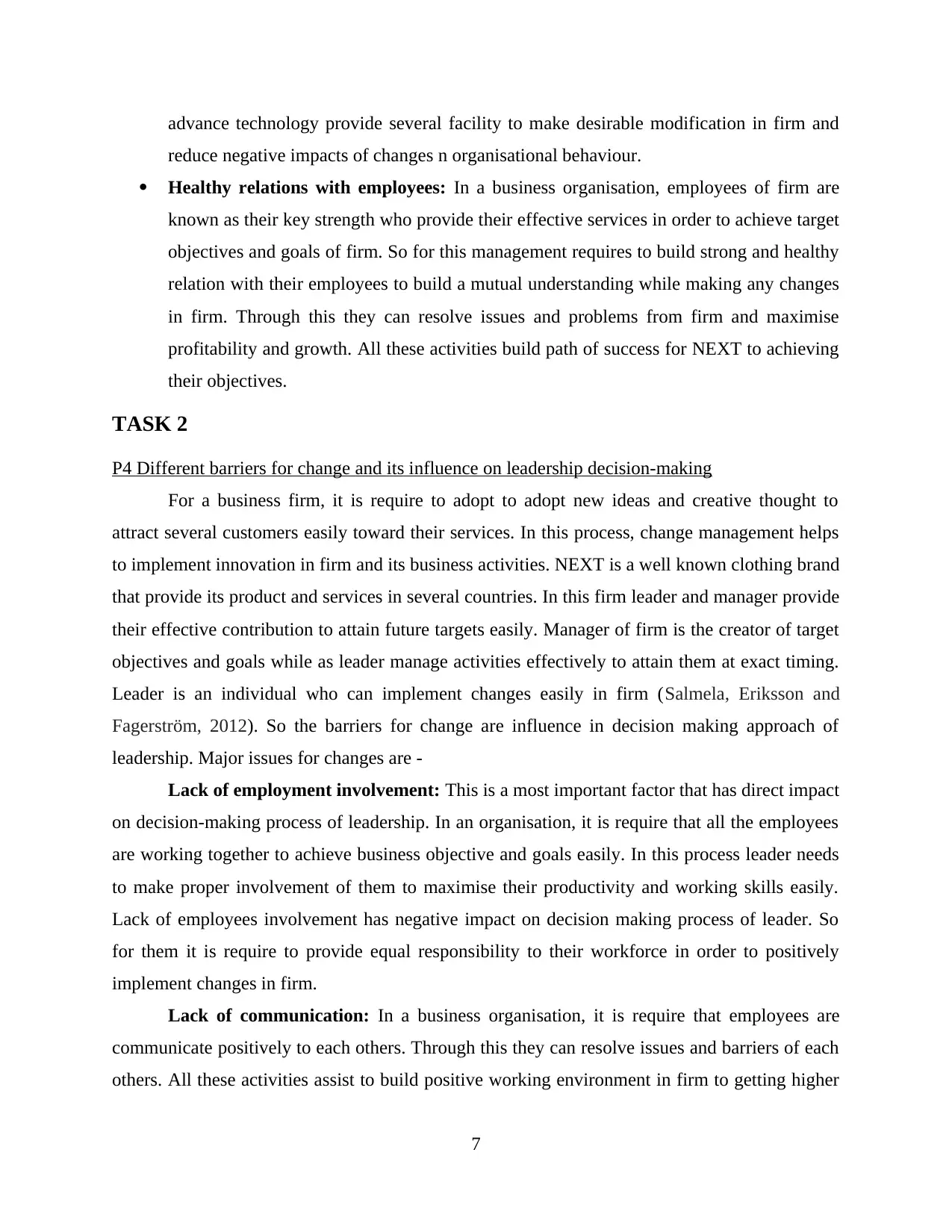
advance technology provide several facility to make desirable modification in firm and
reduce negative impacts of changes n organisational behaviour.
Healthy relations with employees: In a business organisation, employees of firm are
known as their key strength who provide their effective services in order to achieve target
objectives and goals of firm. So for this management requires to build strong and healthy
relation with their employees to build a mutual understanding while making any changes
in firm. Through this they can resolve issues and problems from firm and maximise
profitability and growth. All these activities build path of success for NEXT to achieving
their objectives.
TASK 2
P4 Different barriers for change and its influence on leadership decision-making
For a business firm, it is require to adopt to adopt new ideas and creative thought to
attract several customers easily toward their services. In this process, change management helps
to implement innovation in firm and its business activities. NEXT is a well known clothing brand
that provide its product and services in several countries. In this firm leader and manager provide
their effective contribution to attain future targets easily. Manager of firm is the creator of target
objectives and goals while as leader manage activities effectively to attain them at exact timing.
Leader is an individual who can implement changes easily in firm (Salmela, Eriksson and
Fagerström, 2012). So the barriers for change are influence in decision making approach of
leadership. Major issues for changes are -
Lack of employment involvement: This is a most important factor that has direct impact
on decision-making process of leadership. In an organisation, it is require that all the employees
are working together to achieve business objective and goals easily. In this process leader needs
to make proper involvement of them to maximise their productivity and working skills easily.
Lack of employees involvement has negative impact on decision making process of leader. So
for them it is require to provide equal responsibility to their workforce in order to positively
implement changes in firm.
Lack of communication: In a business organisation, it is require that employees are
communicate positively to each others. Through this they can resolve issues and barriers of each
others. All these activities assist to build positive working environment in firm to getting higher
7
reduce negative impacts of changes n organisational behaviour.
Healthy relations with employees: In a business organisation, employees of firm are
known as their key strength who provide their effective services in order to achieve target
objectives and goals of firm. So for this management requires to build strong and healthy
relation with their employees to build a mutual understanding while making any changes
in firm. Through this they can resolve issues and problems from firm and maximise
profitability and growth. All these activities build path of success for NEXT to achieving
their objectives.
TASK 2
P4 Different barriers for change and its influence on leadership decision-making
For a business firm, it is require to adopt to adopt new ideas and creative thought to
attract several customers easily toward their services. In this process, change management helps
to implement innovation in firm and its business activities. NEXT is a well known clothing brand
that provide its product and services in several countries. In this firm leader and manager provide
their effective contribution to attain future targets easily. Manager of firm is the creator of target
objectives and goals while as leader manage activities effectively to attain them at exact timing.
Leader is an individual who can implement changes easily in firm (Salmela, Eriksson and
Fagerström, 2012). So the barriers for change are influence in decision making approach of
leadership. Major issues for changes are -
Lack of employment involvement: This is a most important factor that has direct impact
on decision-making process of leadership. In an organisation, it is require that all the employees
are working together to achieve business objective and goals easily. In this process leader needs
to make proper involvement of them to maximise their productivity and working skills easily.
Lack of employees involvement has negative impact on decision making process of leader. So
for them it is require to provide equal responsibility to their workforce in order to positively
implement changes in firm.
Lack of communication: In a business organisation, it is require that employees are
communicate positively to each others. Through this they can resolve issues and barriers of each
others. All these activities assist to build positive working environment in firm to getting higher
7
⊘ This is a preview!⊘
Do you want full access?
Subscribe today to unlock all pages.

Trusted by 1+ million students worldwide
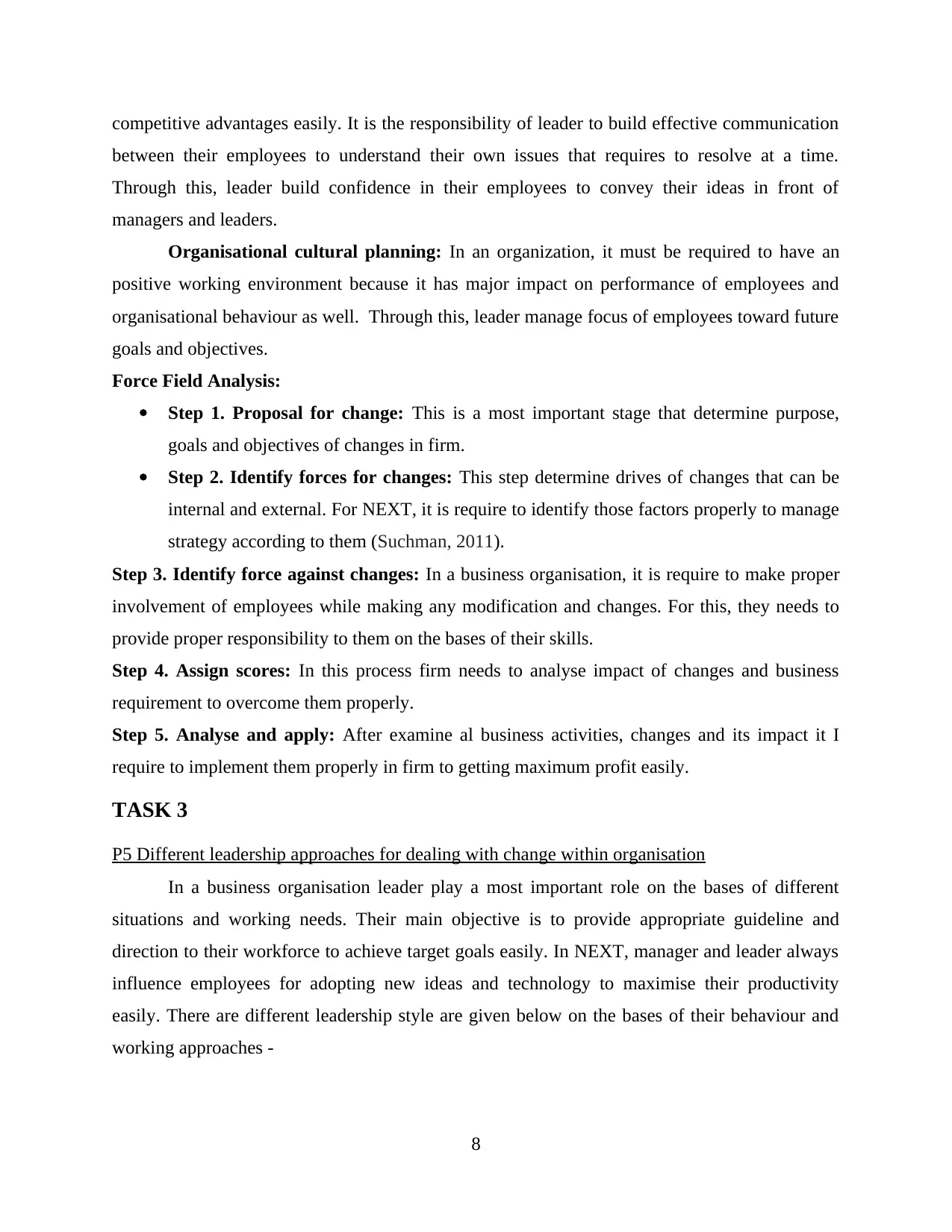
competitive advantages easily. It is the responsibility of leader to build effective communication
between their employees to understand their own issues that requires to resolve at a time.
Through this, leader build confidence in their employees to convey their ideas in front of
managers and leaders.
Organisational cultural planning: In an organization, it must be required to have an
positive working environment because it has major impact on performance of employees and
organisational behaviour as well. Through this, leader manage focus of employees toward future
goals and objectives.
Force Field Analysis:
Step 1. Proposal for change: This is a most important stage that determine purpose,
goals and objectives of changes in firm.
Step 2. Identify forces for changes: This step determine drives of changes that can be
internal and external. For NEXT, it is require to identify those factors properly to manage
strategy according to them (Suchman, 2011).
Step 3. Identify force against changes: In a business organisation, it is require to make proper
involvement of employees while making any modification and changes. For this, they needs to
provide proper responsibility to them on the bases of their skills.
Step 4. Assign scores: In this process firm needs to analyse impact of changes and business
requirement to overcome them properly.
Step 5. Analyse and apply: After examine al business activities, changes and its impact it I
require to implement them properly in firm to getting maximum profit easily.
TASK 3
P5 Different leadership approaches for dealing with change within organisation
In a business organisation leader play a most important role on the bases of different
situations and working needs. Their main objective is to provide appropriate guideline and
direction to their workforce to achieve target goals easily. In NEXT, manager and leader always
influence employees for adopting new ideas and technology to maximise their productivity
easily. There are different leadership style are given below on the bases of their behaviour and
working approaches -
8
between their employees to understand their own issues that requires to resolve at a time.
Through this, leader build confidence in their employees to convey their ideas in front of
managers and leaders.
Organisational cultural planning: In an organization, it must be required to have an
positive working environment because it has major impact on performance of employees and
organisational behaviour as well. Through this, leader manage focus of employees toward future
goals and objectives.
Force Field Analysis:
Step 1. Proposal for change: This is a most important stage that determine purpose,
goals and objectives of changes in firm.
Step 2. Identify forces for changes: This step determine drives of changes that can be
internal and external. For NEXT, it is require to identify those factors properly to manage
strategy according to them (Suchman, 2011).
Step 3. Identify force against changes: In a business organisation, it is require to make proper
involvement of employees while making any modification and changes. For this, they needs to
provide proper responsibility to them on the bases of their skills.
Step 4. Assign scores: In this process firm needs to analyse impact of changes and business
requirement to overcome them properly.
Step 5. Analyse and apply: After examine al business activities, changes and its impact it I
require to implement them properly in firm to getting maximum profit easily.
TASK 3
P5 Different leadership approaches for dealing with change within organisation
In a business organisation leader play a most important role on the bases of different
situations and working needs. Their main objective is to provide appropriate guideline and
direction to their workforce to achieve target goals easily. In NEXT, manager and leader always
influence employees for adopting new ideas and technology to maximise their productivity
easily. There are different leadership style are given below on the bases of their behaviour and
working approaches -
8
Paraphrase This Document
Need a fresh take? Get an instant paraphrase of this document with our AI Paraphraser
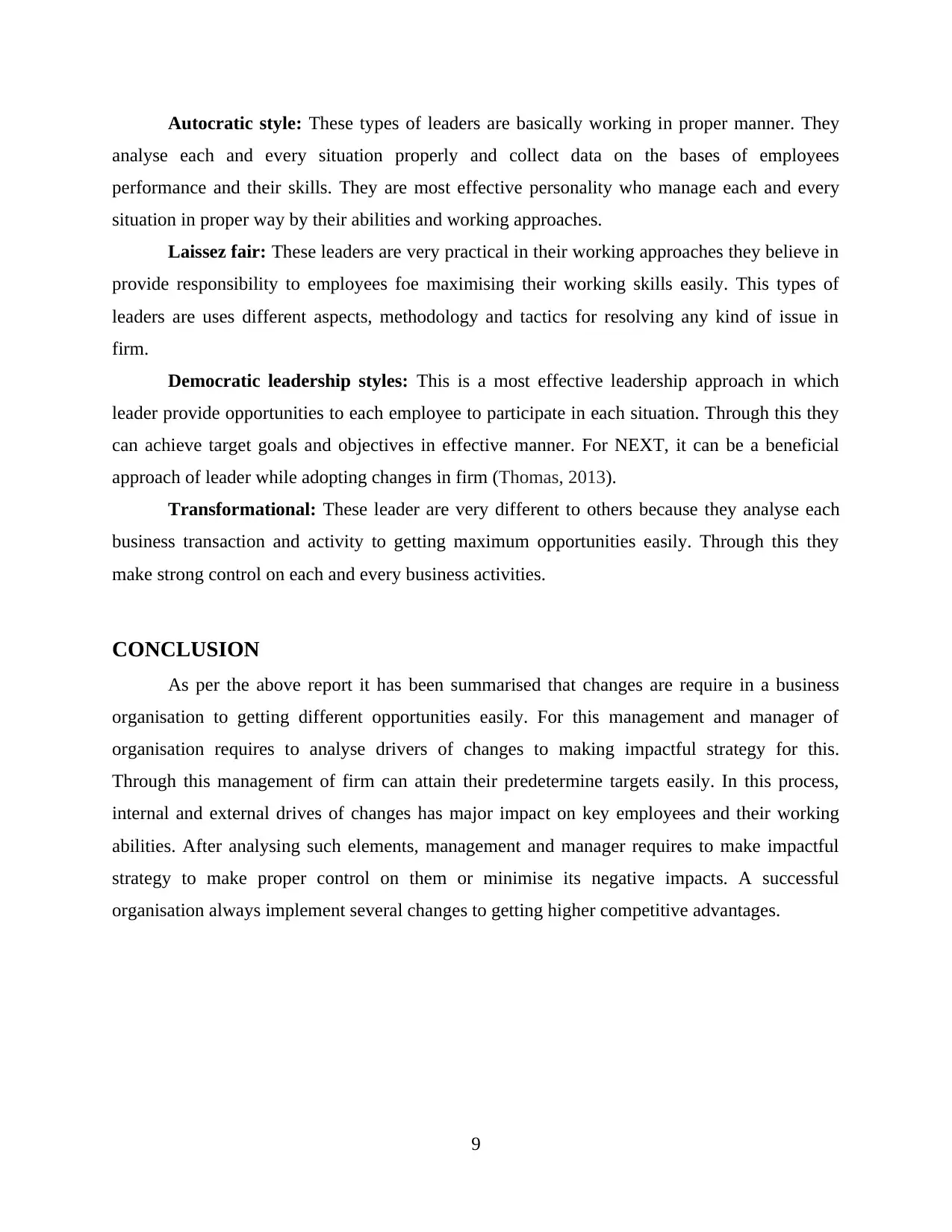
Autocratic style: These types of leaders are basically working in proper manner. They
analyse each and every situation properly and collect data on the bases of employees
performance and their skills. They are most effective personality who manage each and every
situation in proper way by their abilities and working approaches.
Laissez fair: These leaders are very practical in their working approaches they believe in
provide responsibility to employees foe maximising their working skills easily. This types of
leaders are uses different aspects, methodology and tactics for resolving any kind of issue in
firm.
Democratic leadership styles: This is a most effective leadership approach in which
leader provide opportunities to each employee to participate in each situation. Through this they
can achieve target goals and objectives in effective manner. For NEXT, it can be a beneficial
approach of leader while adopting changes in firm (Thomas, 2013).
Transformational: These leader are very different to others because they analyse each
business transaction and activity to getting maximum opportunities easily. Through this they
make strong control on each and every business activities.
CONCLUSION
As per the above report it has been summarised that changes are require in a business
organisation to getting different opportunities easily. For this management and manager of
organisation requires to analyse drivers of changes to making impactful strategy for this.
Through this management of firm can attain their predetermine targets easily. In this process,
internal and external drives of changes has major impact on key employees and their working
abilities. After analysing such elements, management and manager requires to make impactful
strategy to make proper control on them or minimise its negative impacts. A successful
organisation always implement several changes to getting higher competitive advantages.
9
analyse each and every situation properly and collect data on the bases of employees
performance and their skills. They are most effective personality who manage each and every
situation in proper way by their abilities and working approaches.
Laissez fair: These leaders are very practical in their working approaches they believe in
provide responsibility to employees foe maximising their working skills easily. This types of
leaders are uses different aspects, methodology and tactics for resolving any kind of issue in
firm.
Democratic leadership styles: This is a most effective leadership approach in which
leader provide opportunities to each employee to participate in each situation. Through this they
can achieve target goals and objectives in effective manner. For NEXT, it can be a beneficial
approach of leader while adopting changes in firm (Thomas, 2013).
Transformational: These leader are very different to others because they analyse each
business transaction and activity to getting maximum opportunities easily. Through this they
make strong control on each and every business activities.
CONCLUSION
As per the above report it has been summarised that changes are require in a business
organisation to getting different opportunities easily. For this management and manager of
organisation requires to analyse drivers of changes to making impactful strategy for this.
Through this management of firm can attain their predetermine targets easily. In this process,
internal and external drives of changes has major impact on key employees and their working
abilities. After analysing such elements, management and manager requires to make impactful
strategy to make proper control on them or minimise its negative impacts. A successful
organisation always implement several changes to getting higher competitive advantages.
9
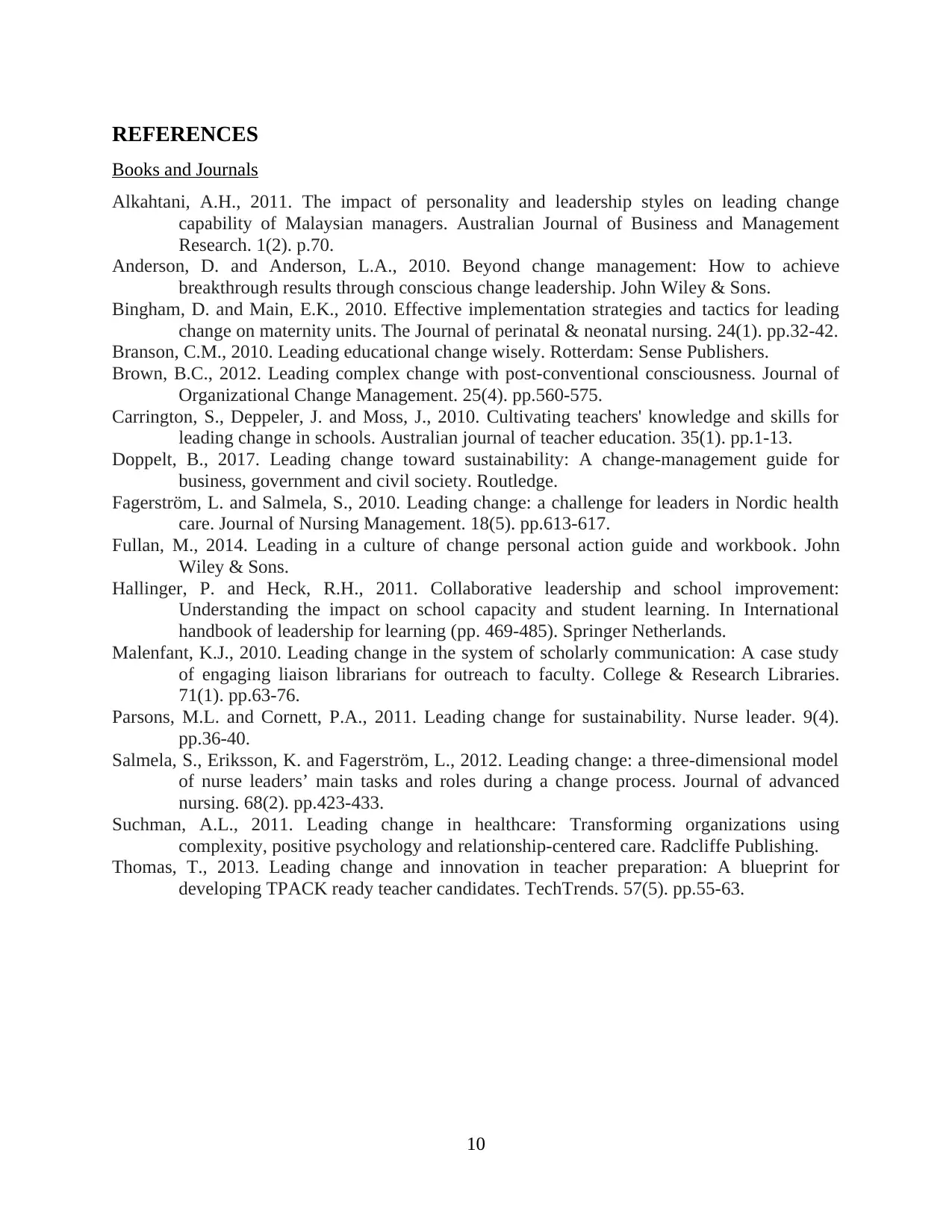
REFERENCES
Books and Journals
Alkahtani, A.H., 2011. The impact of personality and leadership styles on leading change
capability of Malaysian managers. Australian Journal of Business and Management
Research. 1(2). p.70.
Anderson, D. and Anderson, L.A., 2010. Beyond change management: How to achieve
breakthrough results through conscious change leadership. John Wiley & Sons.
Bingham, D. and Main, E.K., 2010. Effective implementation strategies and tactics for leading
change on maternity units. The Journal of perinatal & neonatal nursing. 24(1). pp.32-42.
Branson, C.M., 2010. Leading educational change wisely. Rotterdam: Sense Publishers.
Brown, B.C., 2012. Leading complex change with post-conventional consciousness. Journal of
Organizational Change Management. 25(4). pp.560-575.
Carrington, S., Deppeler, J. and Moss, J., 2010. Cultivating teachers' knowledge and skills for
leading change in schools. Australian journal of teacher education. 35(1). pp.1-13.
Doppelt, B., 2017. Leading change toward sustainability: A change-management guide for
business, government and civil society. Routledge.
Fagerström, L. and Salmela, S., 2010. Leading change: a challenge for leaders in Nordic health
care. Journal of Nursing Management. 18(5). pp.613-617.
Fullan, M., 2014. Leading in a culture of change personal action guide and workbook. John
Wiley & Sons.
Hallinger, P. and Heck, R.H., 2011. Collaborative leadership and school improvement:
Understanding the impact on school capacity and student learning. In International
handbook of leadership for learning (pp. 469-485). Springer Netherlands.
Malenfant, K.J., 2010. Leading change in the system of scholarly communication: A case study
of engaging liaison librarians for outreach to faculty. College & Research Libraries.
71(1). pp.63-76.
Parsons, M.L. and Cornett, P.A., 2011. Leading change for sustainability. Nurse leader. 9(4).
pp.36-40.
Salmela, S., Eriksson, K. and Fagerström, L., 2012. Leading change: a three‐dimensional model
of nurse leaders’ main tasks and roles during a change process. Journal of advanced
nursing. 68(2). pp.423-433.
Suchman, A.L., 2011. Leading change in healthcare: Transforming organizations using
complexity, positive psychology and relationship-centered care. Radcliffe Publishing.
Thomas, T., 2013. Leading change and innovation in teacher preparation: A blueprint for
developing TPACK ready teacher candidates. TechTrends. 57(5). pp.55-63.
10
Books and Journals
Alkahtani, A.H., 2011. The impact of personality and leadership styles on leading change
capability of Malaysian managers. Australian Journal of Business and Management
Research. 1(2). p.70.
Anderson, D. and Anderson, L.A., 2010. Beyond change management: How to achieve
breakthrough results through conscious change leadership. John Wiley & Sons.
Bingham, D. and Main, E.K., 2010. Effective implementation strategies and tactics for leading
change on maternity units. The Journal of perinatal & neonatal nursing. 24(1). pp.32-42.
Branson, C.M., 2010. Leading educational change wisely. Rotterdam: Sense Publishers.
Brown, B.C., 2012. Leading complex change with post-conventional consciousness. Journal of
Organizational Change Management. 25(4). pp.560-575.
Carrington, S., Deppeler, J. and Moss, J., 2010. Cultivating teachers' knowledge and skills for
leading change in schools. Australian journal of teacher education. 35(1). pp.1-13.
Doppelt, B., 2017. Leading change toward sustainability: A change-management guide for
business, government and civil society. Routledge.
Fagerström, L. and Salmela, S., 2010. Leading change: a challenge for leaders in Nordic health
care. Journal of Nursing Management. 18(5). pp.613-617.
Fullan, M., 2014. Leading in a culture of change personal action guide and workbook. John
Wiley & Sons.
Hallinger, P. and Heck, R.H., 2011. Collaborative leadership and school improvement:
Understanding the impact on school capacity and student learning. In International
handbook of leadership for learning (pp. 469-485). Springer Netherlands.
Malenfant, K.J., 2010. Leading change in the system of scholarly communication: A case study
of engaging liaison librarians for outreach to faculty. College & Research Libraries.
71(1). pp.63-76.
Parsons, M.L. and Cornett, P.A., 2011. Leading change for sustainability. Nurse leader. 9(4).
pp.36-40.
Salmela, S., Eriksson, K. and Fagerström, L., 2012. Leading change: a three‐dimensional model
of nurse leaders’ main tasks and roles during a change process. Journal of advanced
nursing. 68(2). pp.423-433.
Suchman, A.L., 2011. Leading change in healthcare: Transforming organizations using
complexity, positive psychology and relationship-centered care. Radcliffe Publishing.
Thomas, T., 2013. Leading change and innovation in teacher preparation: A blueprint for
developing TPACK ready teacher candidates. TechTrends. 57(5). pp.55-63.
10
⊘ This is a preview!⊘
Do you want full access?
Subscribe today to unlock all pages.

Trusted by 1+ million students worldwide
1 out of 12
Related Documents
Your All-in-One AI-Powered Toolkit for Academic Success.
+13062052269
info@desklib.com
Available 24*7 on WhatsApp / Email
![[object Object]](/_next/static/media/star-bottom.7253800d.svg)
Unlock your academic potential
Copyright © 2020–2025 A2Z Services. All Rights Reserved. Developed and managed by ZUCOL.





